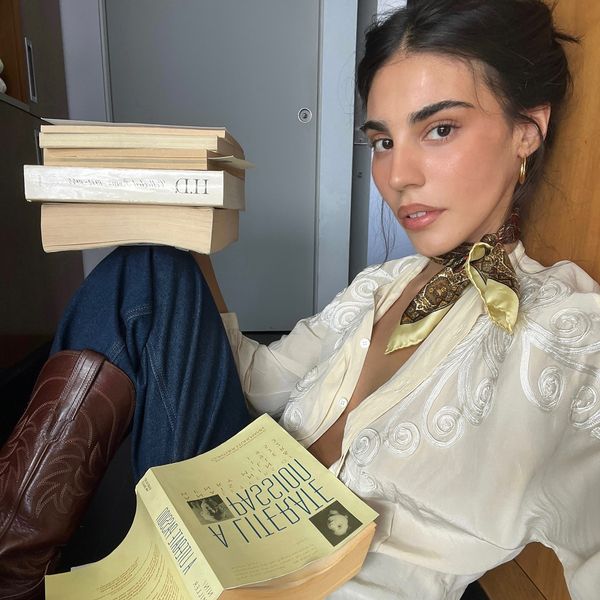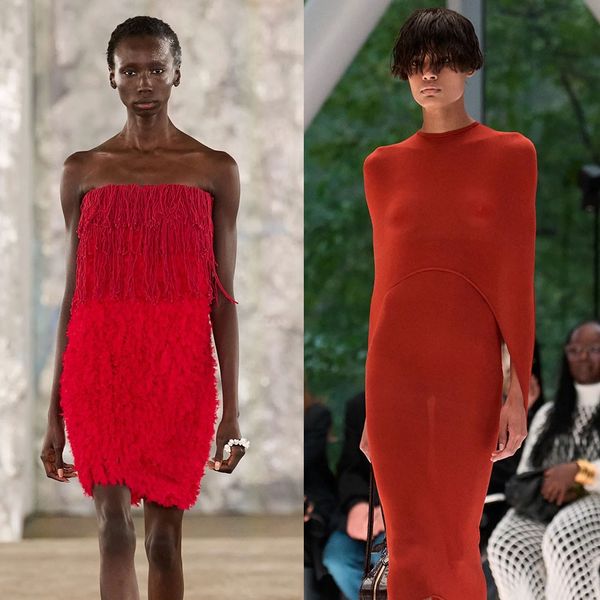Where Have All The Hooded Eyes Gone?
Suddenly, everyone is looking extra wide-eyed and awake. Is upper bleph surgery the reason why?
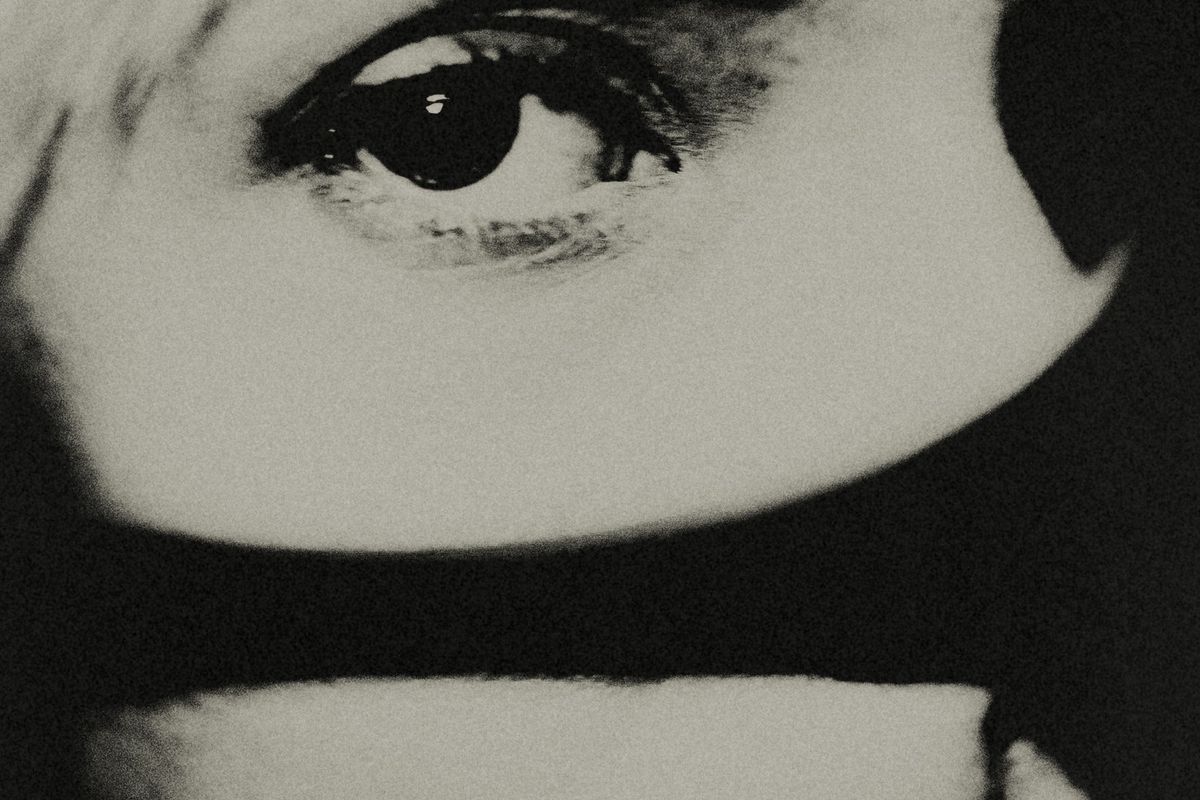
Take a peek at the red carpet these days and there’s a very specific eye shape that’s dominating among a subset of Hollywood. From Jennifer Lawrence to Emma Stone, Lindsay Lohan to Vanessa Kirby, the sculpted and lifted look has become the facial feature du jour of celebs in their 30s and 40s. Naturally, hooded eyes are becoming endangered as the general public gushes about how refreshed, youthful, and vibrant celebs with this updated eye appear. While none have copped to having anything done (other than the usual non-invasive beauty treatments), looking at before and after photos has us asking: where have all the hooded eyes gone?
This trending, wide-eyed look, which Melissa Doft, MD, a double board-certified based in NYC describes as “an oval shape, but where the eyelid almost looks a bit like a cat-eye where there’s a lift to it and it flares up to the side,” is best achieved surgically, she notes (sorry, Botox girlies) with a procedure called an upper blepharoplasty or upper bleph for short.
Upper blephs, which were once the bread and butter for surgeons operating on women 45+, are now becoming more popular with patients in their 30s who are seeking that refreshed, revived look. That’s because, as Robert Schwarcz, MD, a board-certified oculoplastic surgeon in New York City who specializes in blepharoplasties and brow lifts, explains, where many in their 30s may have turned to neuromodulators to try and lift and open the eye area in the past, patients are becoming more savvy to release that injectables can only go so far. “I don't think that neurotoxin is leaving anytime soon because it has a great role in prevention,” he says. “But for the role of remodeling and repositioning, I think people are seeing that it is less reliable and less powerful than a ‘one and done’ surgical lift.”
What Is Upper Bleph Surgery?
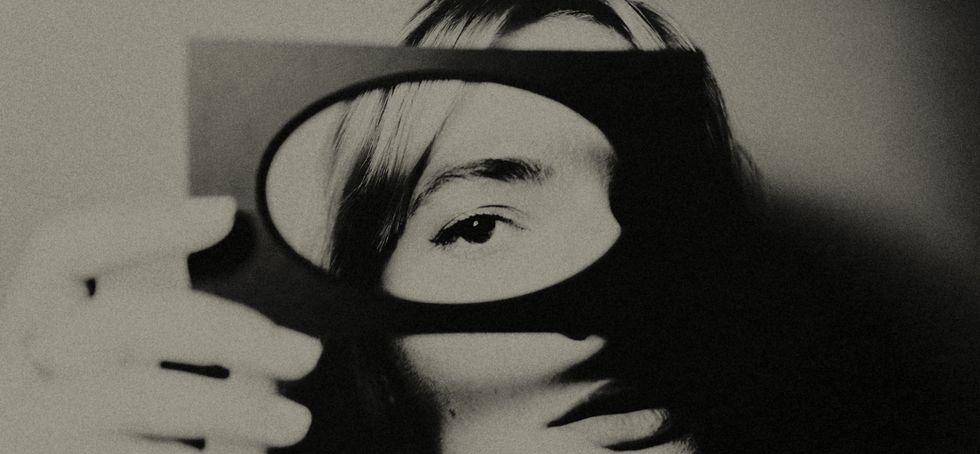
Getty
The typical upper bleph, says Dr. Doft, begins with a small incision along the crease line of the upper eyelid. That incision often extends slightly toward the temple to remove any overhanging skin at the outer corners of the eyes. From there, the surgeon carefully trims away the excess to minimize the hooding while ensuring there’s still enough skin for the patient to comfortably close their eyes afterward.
Depending on the patient, the surgery can involve different layers. “In a young person, there’s usually just a bit of extra skin to remove,” explains Dr. Doft. “For older patients, there’s often more skin—and sometimes we take out a small amount of the orbicularis oculi muscle if the upper eyelid is especially full. If you remove a lot of skin, you don’t want the remaining muscle to feel redundant.”
A third factor is the medial fat pocket, the small pad of fat near the inner corner of the eye that can bulge with age. “As someone gets older, that area can become more prominent,” says Dr. Doft. “In those cases, we’ll often reduce or remove some of that fat for a smoother contour.”
The procedure itself is typically performed under local anesthesia with light sedation rather than full general anesthesia. Most patients are awake but comfortable throughout. Stitches are usually removed within five to seven days, with the majority of swelling and bruising resolving in about a week or two.
The Upper Bleph & Brow Lift Combo
However, upper blephs are only part of the story. Achieving that lifted, cat-eye shape, requires lifting the brow, says Jason Diamond, MD, a double board-certified plastic surgeon in Beverly Hills. “If the brow is falling, or there’s loss of volume to the bone over the brow, if that's the cause of the heaviness and the aged appearance—which often is the case— then you want to lift the brow up just ever so slightly, and that cleans up the upper eyelid,” he explains. “So on many of these younger people, I find that many people misperceive that they've had a blepharoplasty, when in fact, they've had something to elevate their brow.”
Dr. Schwarcz agrees, noting that when talking about a hooded eye versus a more sculpted eye, we can’t have that discussion without mentioning brow lifts and the different variations of them. “Many people did not just have an upper blepharoplasty—they had a temporal brow lift,” he says. “I'm doing exponentially more combo temporal lifts and upper blepharoplasty than upper blepharoplasty only.”
He explains that the first part of the upper eyes that ages is the outer part of the upper eyelid area (which surgeons call the temporal brow) which starts to get heavier and drops down before the center part of the brow drops. “When that gets lifted, oftentimes the temporal lift includes the outer corner of the eye where the upper and lower come together, which gives a more lifted appearance,” he says. By doing the temporal lift first, Dr. Schwarcz says it allows him to be more conservative with how much he has to cut for the upper bleph. “When we do the upper blepharoplasty in my practice, then I need to take out less skin so it's a more natural look,” he says. “When you take out less skin, it still looks fuller and plumper. So it's not just an isolated upper eyelid blepharoplasty of our parents' era, where a ton of skin, muscle, and fat was removed that just makes you look hollowed out—they would have what was called bedroom eyes. That look is no longer desirable.”
He does note that there is a slight concern with creating a skeletonizing effect, so he takes measures to counteract that. “I often put fat into upper eyelid complexes so that it looks a little bit more robust over there,” says Dr. Schwarcz. “Even though I'm removing some skin and lifting up the brow, I'm still often adding fat to the upper eyelid area between the crease and the eyebrow. That gives a more youthful, plump look up there, in addition to this lifted look from the temporal lift.”
Upper Bleph vs. Double Eyelid Surgery
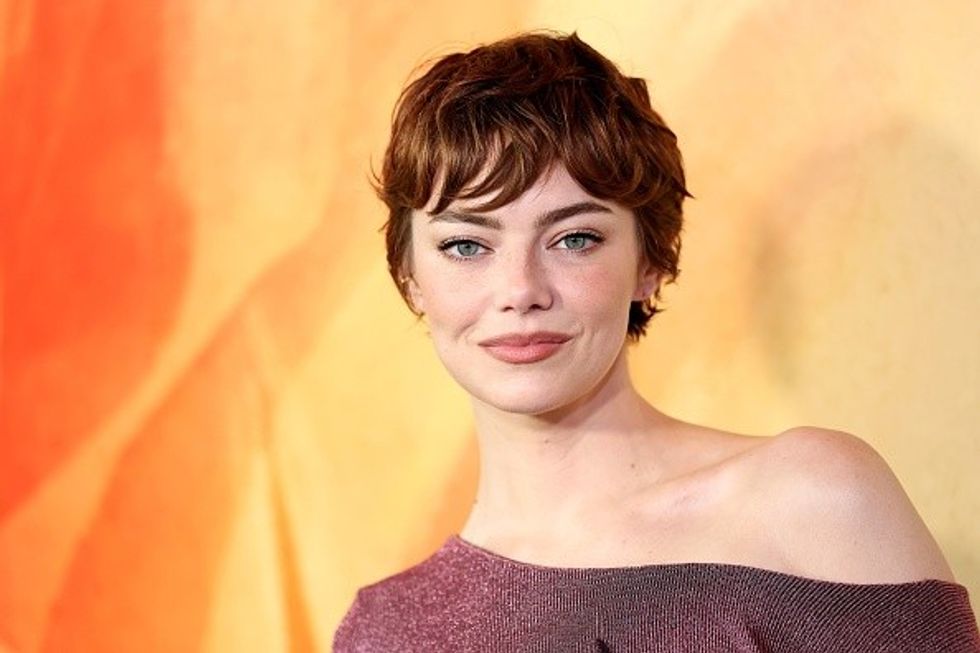
Monica Schipper/Getty
With all this talk about the eyes and upper blephs, the conversation has to turn to a type of blepharoplasty known as double eyelid surgery or Asian eyelid surgery, which is a completely different surgery than an upper bleph or brow lift, explains Gabriel Chiu, DO, a board-certified plastic surgeon and founder at Beverly Hills Plastic Surgery in Beverly Hills. While an upper bleph is designed to remove excess skin, muscle, and fat from the upper eyelid to correct droopy lids, he explains, Asian eyelid surgery is a specialized procedure to create or refine what’s known as the “supratarsal crease” (the fold that forms the “double eyelid”).
“About half of people of Asian descent are born without this crease, and this surgery adds or enhances it,” he says. “This is done to make the eyes appear larger, more defined, or to create symmetry between the two eyes. It’s not about anti-aging or sagging skin, but about reshaping the anatomy to add a crease where it isn’t naturally present. The result is a natural looking double eyelid that matches the patient’s desired style, whether low, medium, or high crease, depending on their anatomy and aesthetic goals.” He mentions that surgery can be customized to add or maintain a more “Asian look” by tapering the crease, or you can “Westernize the look” by reducing the medial epicanthal fold.
Eye Trends & The Future
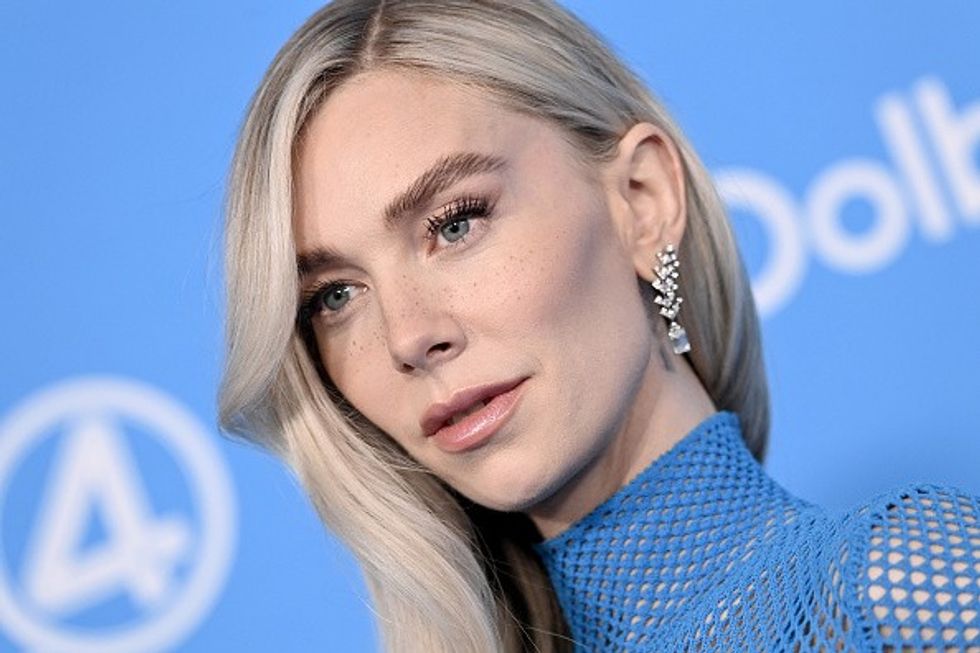
Axelle/Bauer-Griffin/Getty
This new sculpted eye has been earning LiLo 2.0 and her refreshed Millennial celeb cohort rave reviews. For a time, it’s all anyone could talk about. So it makes sense that the conversation in plastic surgery has naturally shifted towards upper blephs. “When you look at stars like Lindsay Lohan, Emma Stone, Vanessa Kirby, and Jennifer Lawrence, one thing stands out: their eyes look brighter, more open, and youthful, with the hooding erased and the lid and crease beautifully defined,” says Dr. Chiu. “With less heaviness around the eyes, subtle expressions are more visible, making someone look approachable, awake, and even more photogenic.” He notes that while blepharoplasty and brow lifts have been around for decades, celebs are now going for subtle refinements rather than dramatic changes. “It’s about restoring the light and shape around the eyes while keeping the person looking like themselves,” he says.
Which all sounds great, unless you’re someone who naturally has a hooded eye or heavier brow. Then the impression might become that hooded eyes are a feature destined to be sculpted and lifted in order to emulate that lighter look seen on the red carpet. It especially becomes a more problematic discussion for Asian patients, who have already been bombarded with Eurocentric beauty ideals and surgeries meant to emulate those features. “Beauty ideals have historically been Eurocentric, and anytime a single aesthetic is glamorized, there’s the danger of patients feeling their natural features are insufficient,” says Dr. Chiu. “We saw this during the Korean plastic surgery boom of the 2010s, when many procedures were heavily marketed around making eyes bigger or more Westernized. Some people were empowered by that choice, but others felt pressured to erase features tied to their identity.”
However, a lot has changed since 2010, mainly our attitudes towards plastic surgery and ourselves. As Dr. Chiu explains, “In 2025, I'm noticing a more thoughtful patient population. Many want subtle refinement rather than dramatic change, with a growing number wanting to preserve their ethnic features while simply reducing heaviness, asymmetry, or functional concerns.” In general, patients are more aware of cultural conversations, asking whether they will still look like themselves, rather than requesting that they look like a specific celebrity. “I always emphasize that surgery should never be about conforming to someone else’s standard. It’s about aligning your appearance with how you want to feel,” says Dr. Chiu.“Hooded eyes, monolids, or deep creases are all beautiful. Surgery should be a choice to enhance comfort, confidence, or harmony, not erase heritage.”
While plastic surgeons aren’t necessarily seeing a rush of people asking specifically for a brow lift or upper bleph, there has been a clear shift in focus.
“I haven't found more people asking about a bleph, per se,” says Dr. Diamond. “They're calling me saying, ‘I want Kendall Jenner's brow aesthetic. I want Zöe Kravitz’s brow aesthetic.’ I think it focuses on balance and symmetry. For sure, the eyes are part of it, but how the brow and lid relate to the eye itself is all part of it.”
He adds that this interest isn’t new: “I've always seen people who make a living with their faces. And this type of person is always saying they want a more elegant look to the upper third of their face—which involves the lower eyelids, the upper eyelids, the brow aesthetic, and the hairline position.”
Ultimately, Dr. Diamond says, it’s less about one procedure and more about the overall effect: “Some people have a naturally hooded eye. Some have a naturally open eye. People just want to redefine their natural beauty. They want a balanced, elegant look—and whatever that takes.”

